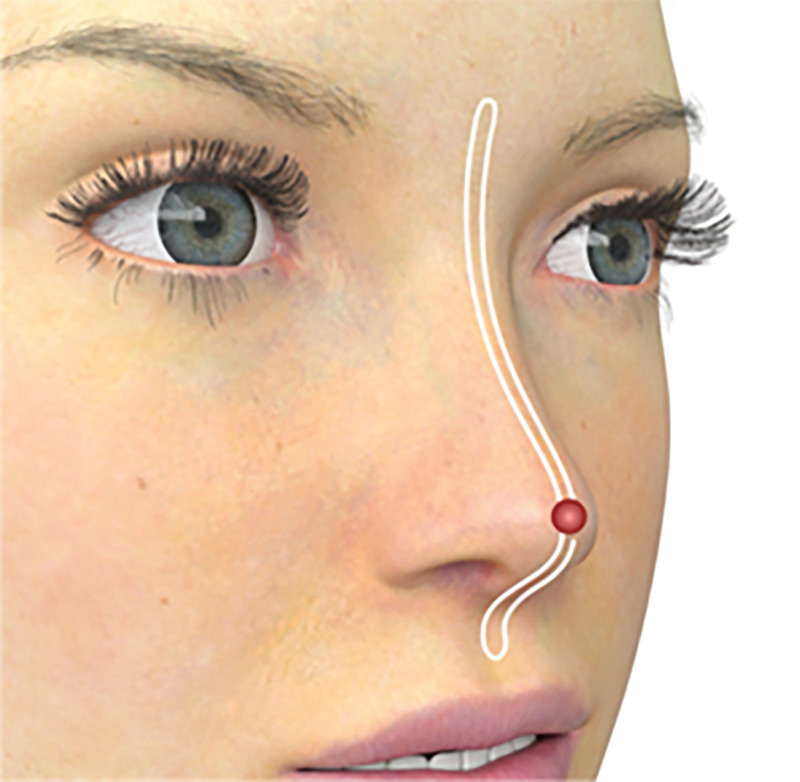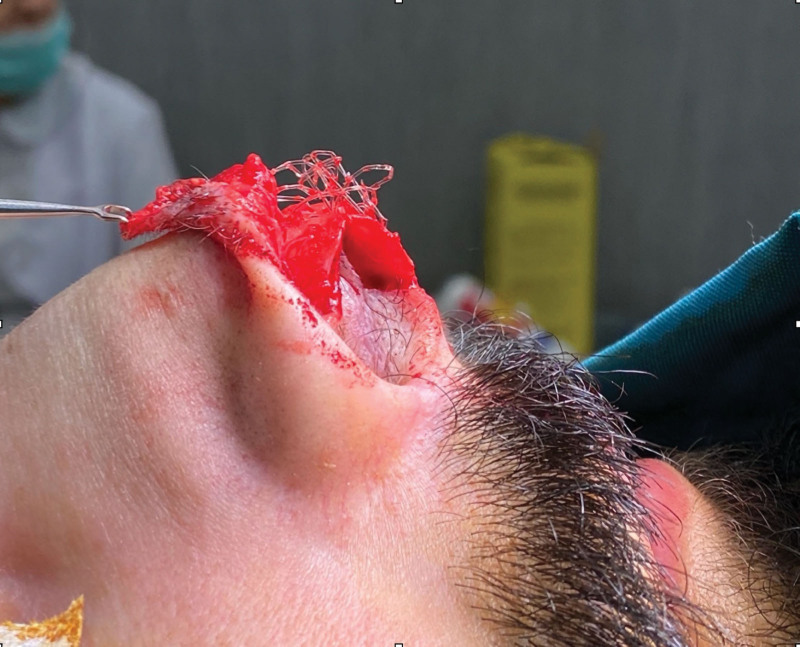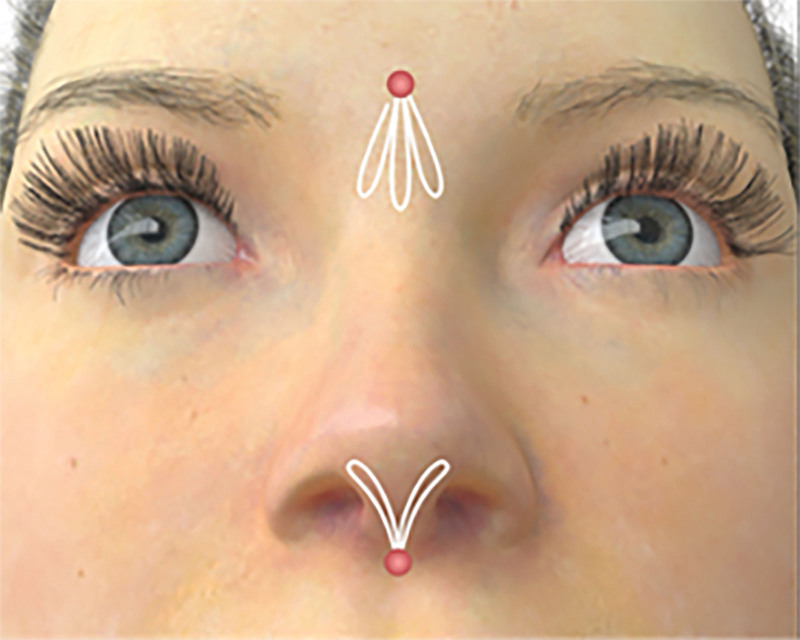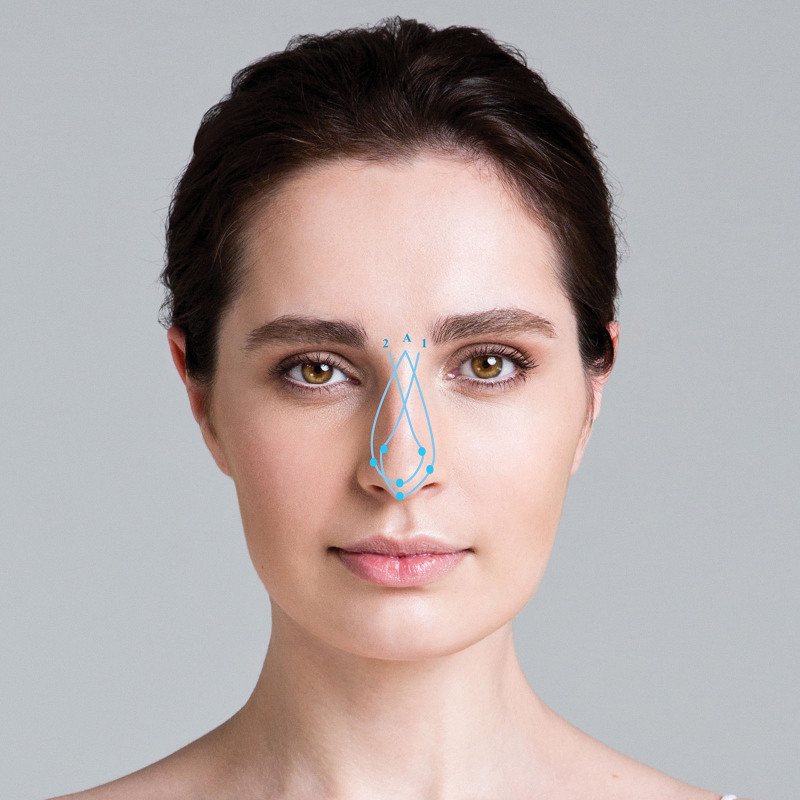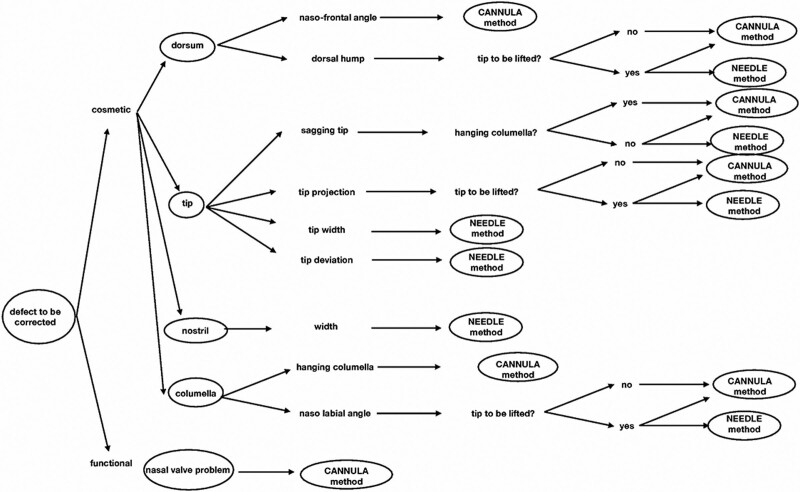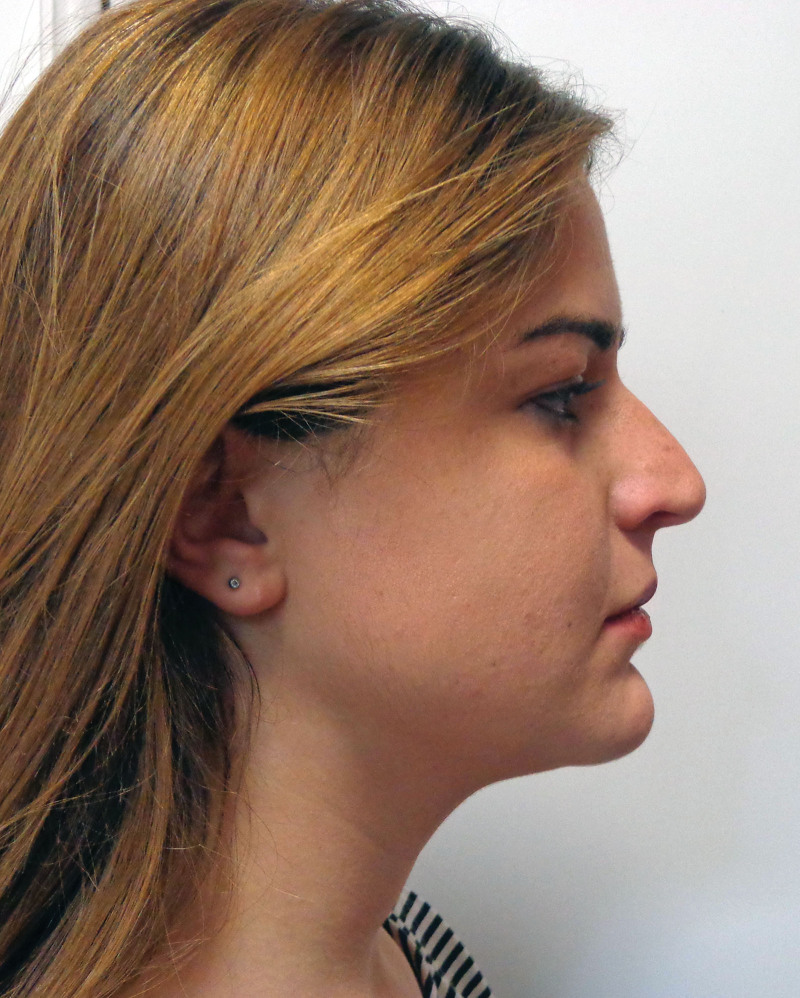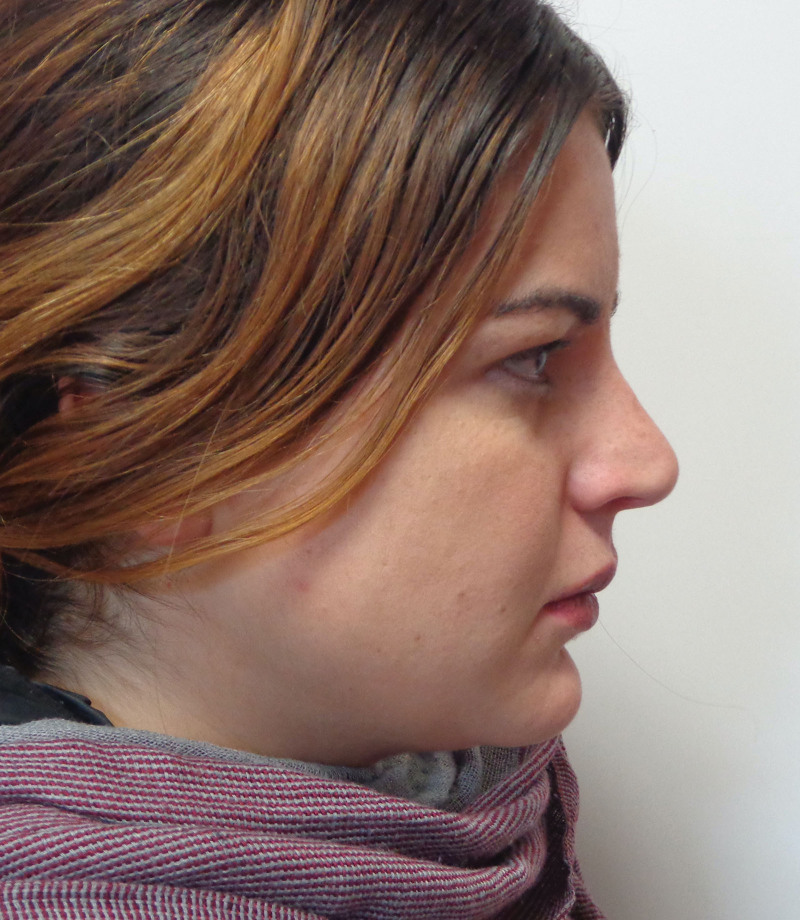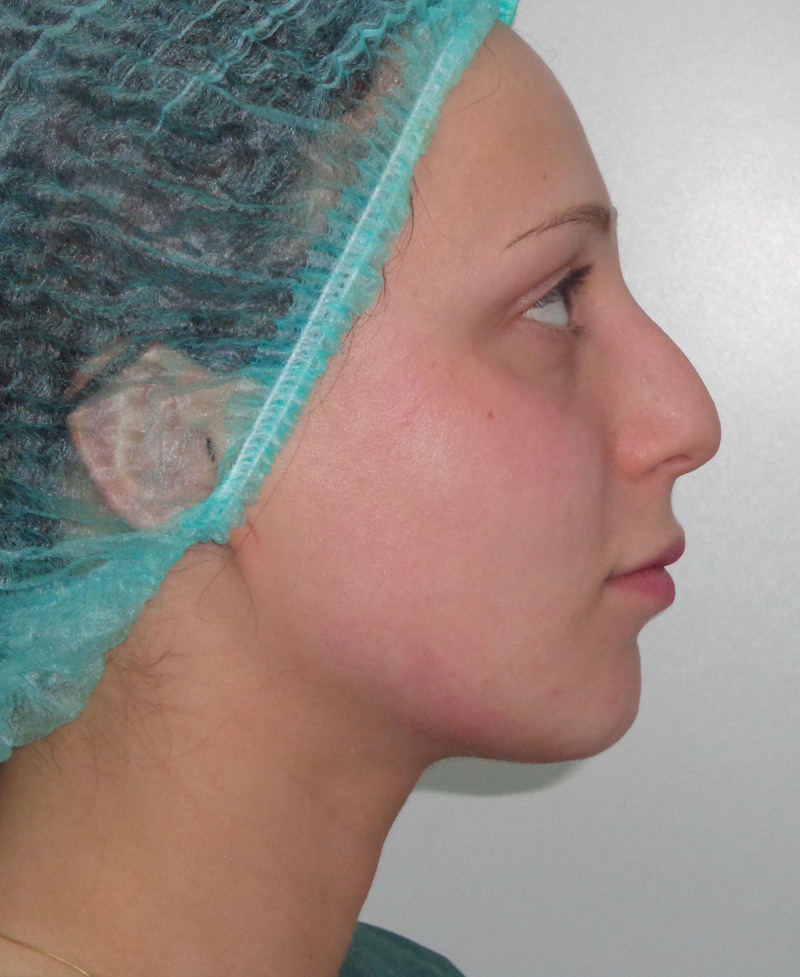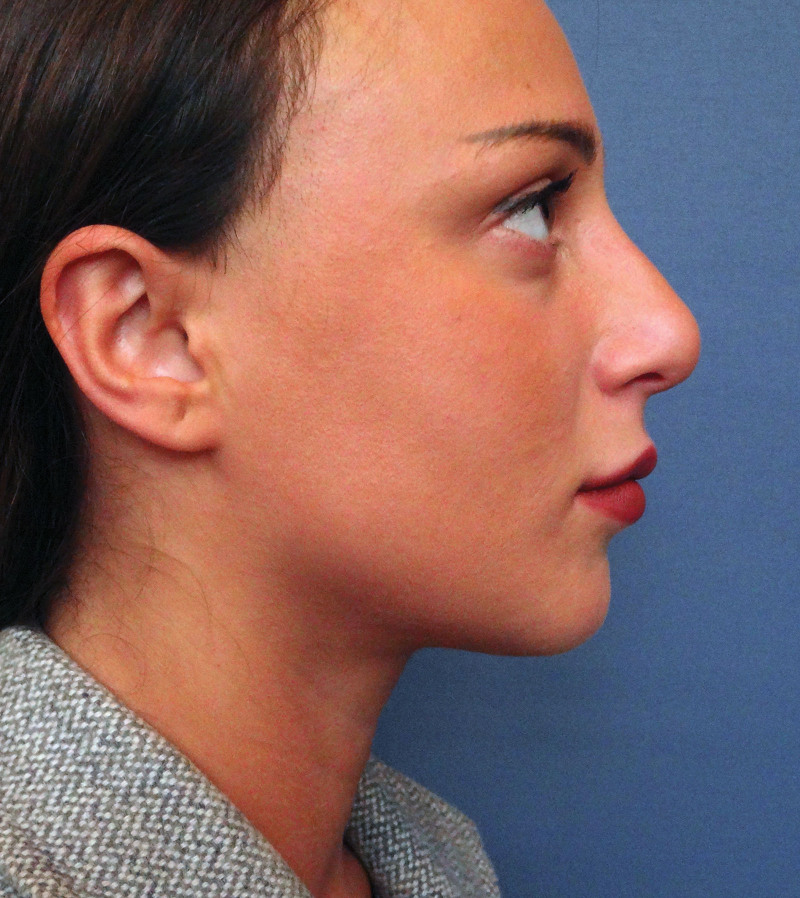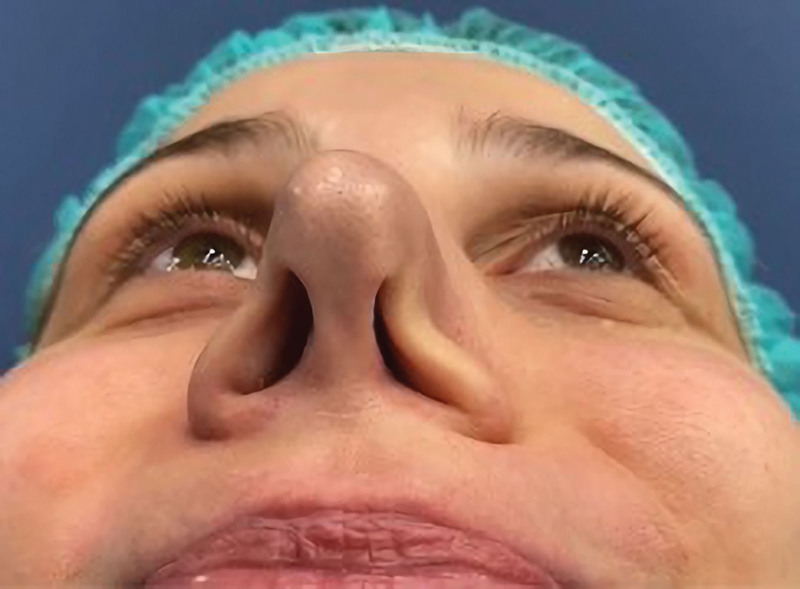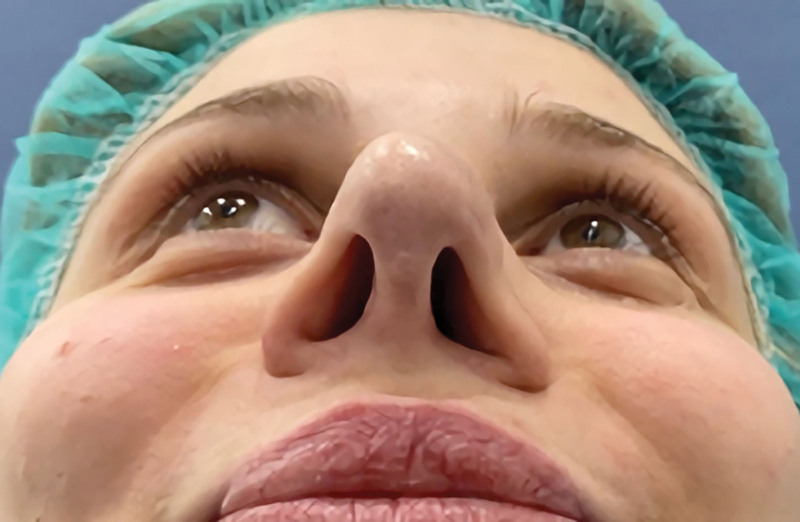Background:
Nose thread lifting is a relatively recent technique. It offers a chance to approach nose morphology defects without turning to surgery to obtain a temporary improvement. Nevertheless, it lacks standardization and it can therefore offer quite variable results and short durability. The authors’ experience is presented here along with a recommended methodological approach to deliver reliable techniques for predictable results. Thread lifting techniques for nose reshaping by means of insertion of poly-L-lactic/poly-caprolactone threads are presented, based on principles of graft-based techniques, to obtain temporary morphological correction of selected nose deformities.
Methods:
A total of 553 patients underwent nose reshaping using poly-L-lactic/poly-caprolactone threads. Of the procedures, 471 were primary treatment, and 82 were secondary treatment after a previous rhinoplasty. The mean follow-up period was carried out through patient photographs and lasted 33.4 months (range 2–60 months). Clinical examinations and patient satisfaction surveys were done at 6 months and 1 year from thread lifting.
Results:
The Freiburg questionnaire survey (subjective Global Aesthetic Improvement Scale) allowed the authors to confirm a 95% satisfaction rate after 6 months, and 62% at 1 year after treatment. A flow chart based on the recorded results is presented to support operators in selecting the proper correction method to adopt, based on the different listed indications.
Conclusions:
Nose reshaping techniques with poly-L-lactic/poly-caprolactone threads are presented together with patients’ treatment satisfaction. Standardization is based upon the authors’ experience. Contraindications and encountered complications are discussed, so as to provide the readers with a complete “state-of-the art” presentation of these techniques. In the authors’ experience, this is a reliable and safe approach to obtain temporary amelioration of selected nose defects via a nonsurgical and minimally invasive method.
Takeaways
Question: Is it possible to reshape the nose by means of resorbable threads?
Findings: The authors present their experience and reliable and safe approach to obtain temporary amelioration of nose defects via a nonsurgical, minimally invasive method.
Meaning: Nose thread lifting methods are now standardized as a reliable technique for the correction of selected nose deformities.
INTRODUCTION
Surgical rhinoplasty is the gold standard for the treatment of nasal deformities, and one of the most performed cosmetic surgery procedures.1 Nevertheless, not all patients asking for cosmetic nasal surgery require a complete rhinoplasty procedure.
Due to market availability of different cross-linked fillers and to their minimal invasiveness and short downtime, many patients began benefitting from a novel nose treatment based on dermal fillers, and in the last 10 years this technique has been further developed.2,3 Furthermore, regardless of what is used, the procedure is effective simply because of volume augmentation.4–8 However, this is not always desirable and risk-free, due to the renowned complex vascular anatomy of nasal skin.9–14
Sutures are part of codified rhinoplasty procedures aimed at achieving nasal tip projection and rotation and reshaping of the nasal tip area.15,16 Likewise, numerous techniques can be found in the literature on how to improve tip rotation and projection via the caudal septum as a pillar for anchorage.17–20 They are also used in aesthetic surgery to lift sagging tissues.21–26
In 2010, the first nose reshaping done by threads was presented27 as an office-based procedure to correct some selected flaws. This procedure, however, cannot be considered fully nonsurgical, given that there are defined procedural steps and skills required to perform it.
With the progressive increase of the above-mentioned complexities, various authors began reconsidering threads as a valid alternative to perform medical nose correction, and alternative options then became available in the literature in the last few years.28–30
Standardized nose anthropometric points, clinical landmarks, lines, and angles are to be taken into account to properly foresee the results, and a lot of systematic analysis methods are present in the literature.31–35 Nevertheless, a methodological approach to thread lifting of the nose is still lacking, and available papers are mostly focused on specific techniques and insertion devices, used alone or in combination with fillers.
The aim of this paper is therefore to share the authors’ experience with thread lifting of the nose, along with a comprehensive algorithmic approach focused on results-driven techniques.
MATERIALS AND METHODS
Between January 2017 and December 2019, 553 nose corrections with threads, 469 with the Excellence Visage method (Aptos LLC, Tbilisi, Georgia) and 84 with the Sole Rhinoplasty Needle method (Aptos LLC, Tbilisi, Georgia), were performed. All patients had not undergone previous rhinoplasty, except 82 who underwent thread insertion as secondary surgery.
The study protocol followed the ethical guidelines of the Declaration of Helsinki, and informed consent was acquired from all patients.
Patient photographs were taken using a Nikon digital SLR D90 12.3 Mpixel camera (Nikon, Tokyo, Japan). All patients consented to the reproduction of recognizable photographs.
Preoperative Assessment
Previous skin type and texture assessment is mandatory; if skin is thick and sebaceous, it will not drape as well as thin skin, and it will take longer for the edema to subside before the result is seen. Thin skin sometimes drapes too excessively, and as the edema subsides, underlying thread loops will become visible.
As no surgical dissection must take place and because all cartilage correction is planned ahead, it is strongly advised to assess by palpation, prior to thread insertion, the actual length of the paired nasal bones and the cartilaginous framework of the nose, along with the presence of any bony or cartilaginous irregularities on the midline or along the lateral aspects of the dorsum.
Furthermore, the antero-inferior portion of the septal cartilage, normally hidden between the two domes, must be evaluated against the most projecting point of the lobule. Finally, evaluation of the amount of resistance offered by the cartilaginous dorsum and nasal tip to posterior displacement completes the fundamental structural assessment.
Thread Selection
Enrolled participants all underwent insertion of resorbable poly-L-lactic/poly-caprolactone PLLA-PCA (Excellence Visage and Sole Rhinoplasty Needle method, Aptos LLC, Tbilisi, Ga.) suspension threads to correct nose morphology.
Excellence Visage is a resorbable, 2/0 thread preloaded in a blunt cannula. Barbs are bi-directional; therefore, the thread settles within the surrounding tissues. In the authors’ experience this is the safest and least technically demanding method; the thread is used to provide a stronger framework to support nasal tissues once it is inserted.
Sole Rhinoplasty Needle is a resorbable PLLA-PCA 2/0 thread inserted in the middle of a double sharp-ended needle. Barbs are monodirectional in each half of the thread: the main fixation is located at the insertion point on the nasal root, and the barbs provide for its additional distribution along the thread. This method is more effective and indicated when major deformities are addressed because it suspends the nose from its insertion point and strongly secures the nasal tissues with loops.
Surgical Technique
Face skin disinfection is carried out with iodopovidone 10% or chlorhexidine 0.5%, and then local anesthesia of the nostrils and the columella is performed with a solution of 1:100,000 adrenaline in lidocaine 2% using a 30G 13-mm-long needle in the canine fossa bilaterally, whereas anesthesia of the tip and the dorsum is obtained through cannula infiltration from a unique entry point on the nose tip with a 18G needle.
A 15-minute wait ensures proper vasoconstriction of the superficial vessels, a sterile surgical field is then set out, and threads are inserted.
The adopted techniques are described here. The Excellence Visage method requires the insertion point to be opened on the nose tip with an 18G needle. The thread is therefore inserted and fixed in the nasal superficial muscular aponeurotic system above the nose root in the procerus muscle, the cannula is then retracted, and the thread is fixed along the dorsum tissues. Once the insertion point is again reached, the cannula is flipped without exiting the skin and inserted in the columella inwards to the nasal spine (Fig. 1). (See Video 1, which shows nose reshaping done by thread loaded on cannula.) This passage will have to be repeated using the whole thread length, as this will form and define the new framework. The barbs are responsible for establishing columellar strength, tip position and projection and dorsum defect correction.
Fig. 1.
Nose reshaping done by thread loaded on cannula.
Video 1. This video displays the nose reshaping of a ptosic tip and technique to correct by volume addiction harvesting multiple loops done by thread loaded on blunt tip cannula.
If the Excellence Visage loaded cannula method is used, then once the cannula is inserted, it is necessary to move it upward to affect tip position and nasolabial angle, providing the maximum possible correction, while also holding the nose in the desired position with one’s non-dominant hand, and fixing it with the barbs which strengthen and stabilize the columella, thus providing tip support. Several passages of the thread are made to create a splint as if it were a columellar strut. When more tip projection is desired, loops of the threads are passed in, by multiple rotations of the cannula, acting like a shield graft (Fig. 2).
Fig. 2.
Intraoperative detail which shows thread loops acting as a projecting shield graft.
Nasal dorsum correction, if requested, first requires the operator to lift the tip up and assess tissue volumes. Afterward, if concave dorsum correction is needed, or concealment of a dorsal hump, volume is added by creating multiple loops of the thread via numerous circular “to-and-from” movements of the tip of the cannula where volume increase is needed and planned (Fig. 3). (See Video 2, which shows technique to correct by volume addition, harvesting multiple loops.)
Fig. 3.
Technique to correct by volume addition, harvesting multiple loops.
Video 2. This video displays the nasal valve correction carried out by threads.
If naso-frontal angle correction is desired, care must be taken to insert the thread upward and downward to the procerus muscle for enhancement of the result.
Whenever external nasal valve problems are known, threads might be inserted parallel to the nostril margin, above the lateral dome, and this would therefore act as an alar batten graft, which strengthens the cartilaginous framework and prevents its collapse during breathing.
Conversely, the Sole Rhinoplasty Needle method has the insertion point located at the nose root. The two needles are both inserted, and one is passed down along the dorsal line toward the tip defining point, which is therefore surrounded by a loop passed along the inferior margin of the alar cartilage and, once it is passed over the nasal tip, it goes back to the nasal root. The second needle is inserted in the same way on the opposite side, eventually ending in a double loop around the nasal tip and domes (Fig. 4).
Fig. 4.
Nose reshaping done by thread loaded on needle: entry point A for both needles is located at the root of the nose; one loop is made with each thread using the double end tip needle toward the tip defining points (blue spots) and back to exit points 1 and 2, respectively, which are laterally to the median line.
To modify tip position and, consequently, nasolabial angle, it is necessary to move the tip upward, providing the maximum correction available; the new position is fixed both by the barbs and by thread loops.
Tip projection is obtained by tightening the loops at the tip. Practically, the tip is pinched by the operator’s non-dominant hand, and it gets fixed in its craniocaudal position so as to keep it in that position, similarly to what an interdomal suture would do.
If the loops are passed widely around the tip, then their tightening allows them to narrow both the tip and the nostrils.
Nasal dorsum correction can be obtained indirectly by lifting the tip, as this leads to tissue heaping when the loops get tightened.
To treat internal nasal valve dysfunction, threads are inserted subcutaneously at the nose root, then passed through the cartilage under the nasal mucosa and flipped back to the subcutaneous layer. This passage is repeated twice, and once the needle is withdrawn from the skin, the thread is tightened, thus opening the angle of the inner valve and avoiding its collapse.
Pain control is normally achieved with paracetamol 1000 mg, administered orally two to three times per day, for 3 days after the procedure.
The presented results helped the authors subsequently deliver a flow chart to support operators in choosing the proper correction methods for each individual indications (Fig. 5).
Fig. 5.
Nose thread-lifting treatment flow chart.
RESULTS
Starting from the patient’s requests, eight main defects were reported to authors for correction:
Concave or under-projected nasal dorsum (low nasal bone)
Dropped nasal tip
Hanging columella (dropped columella)
Nasolabial angle correction (tip–lip angle correction)
Wide tip
Wide nostrils
Nasal tip deviation (only if septoplasty is unnecessary)
Nasal valve issues
The mean recorded follow-up was 33.4 months, ranging from 2 to 60 months.
The Excellence Visage method is supposed to be used for the following corrections (Figs. 6 and 7; See figure 1, Supplemental Digital Content 1, which shows the frontal and oblique view prior to, 6 months after, and 1.5 years after treatment. http://links.lww.com/PRSGO/C500):
Fig. 6.
Nose reshaping with cannula thread: lateral view, before treatment of hypoprojected tip.
Fig. 7.
Nose reshaping with cannula thread: lateral view, 1.5 years after treatment.
Concave or under-projected nasal dorsum (low nasal bone): treated by carrying out multiple loops in the concavity to project the overlying tissue of the low dorsum thus concealing the deformity by camouflage. Widening of the naso-frontal angle (if desired) requires insertion of the thread upward and downward from the procerus muscle.
Dropped nasal tip: treated by multiple threads insertion from the tip cephalad along the midline and into the columella. This provides a nasal framework that can be maintained in the elevated position by the barbs of the inserted threads. Some extra loops in the tip also allow for further projecting it, if needed, similarly to what a shield graft would do.
Hanging columella (dropped columella): treated by carrying out multiple loops in the columella as if it were a strut.
Nasolabial angle correction (tip–lip angle correction): treated by multiple threads insertion from the tip cephalad along the midline and in the columella to elevate the tip and providing columella support by carrying out multiple loops at its base, thus widening the angle.
For selected cases of external nasal valve problems (Video 2), these are treated by multiple threads linear insertion above the lateral crura of the alar cartilage, acting like an alar batten graft. In this case, it is mandatory to avoid loops that would alter the profile of the overlying skin.
It should be emphasized that the preloaded thread in the blunt cannula option (Excellence Visage method, Aptos LLC, Tbilisi, Ga.) allows for mild corrections only because its action is not that powerful: the rationale here is to basically provide structural support rather than pulling or pinching the nose.
Moreover, thread loops grant a volumizing effect that can be compared with that of injectables: the dissection made by the blunt cannula carries out a similar task, by triggering production of tissue around the thread at a subcutaneous level, where the volumetric augmentation is planned, and it also avoids renowned vascular risks.
The Sole Rhinoplasty Needle method has instead proved to be effective (Figs. 8 and 9) in dealing with the following (See figure 2, Supplemental Digital Content 2, which displays the nose reshaping with needle thread of patient in Figures 7 and 8: frontal and oblique view prior to and 1.8 years after treatment. http://links.lww.com/PRSGO/C501) (See Video 3 which shows nose reshaping done by thread loaded on sharp tip needle; See Video 4 which shows the nose reshaping of a under-projected tip with low nasal dorsum, done by thread loaded on sharp tip needle, combined with surgery):
Fig. 8.
Nose reshaping with needle thread: lateral view, before treatment of dorsal hump and hypoprojected tip.
Fig. 9.
Nose reshaping with needle thread: lateral view, 1.8 years after treatment.
Video 3. This video displays the primary nose reshaping of a ptosic, globous tip done by thread loaded on sharp tip needle.
Video 4. This video displays the nose reshaping of a underprojected tip with low nasal dorsum, done by thread loaded on sharp tip needle, combined with surgery.
1. Concave or under-projected nasal dorsum (low nasal bone): corrected indirectly by tissue heaping when the right and left loops are closed.
2. Dropped nasal tip: treated by suspending the tip once it is surrounded by right and left loops, and then fixing it into the elevated position with the loops themselves and their barbs too. To further project it, it is necessary to tighten the loops.
3. Hanging columella (dropped columella): the columella is lifted and elongated by the upward movement of the suspended nasal tip.
4. Nasolabial angle correction (tip–lip angle correction): the upward movement of the elevated tip also widens this angle.
5. Wide tip (see 6)
6. Wide nostrils: the latter two are both corrected by tightening the wide loops around them
and selected cases of:
7. Nasal tip deviation (only if septoplasty is not necessary): loops are tightened with different degrees of tension in order to have a side movement of the tip.
8. Internal nasal valve problems (Figs. 10 and 11): these are treated by using loops that allow opening up of this angle and avoid its collapse.
Fig. 10.
External nasal valve correction: pretreatment.
Fig. 11.
External nasal valve correction: 8 months posttreatment.
The thread fixed on a double sharp end needle (Sole Rhinoplasty Needle method, Aptos LLC, Tbilisi, Ga.) allows for a much stronger manipulation of the nose, with great potential for reshaping thanks to the loops and the length of the thread itself. Results therefore possess a bigger longevity but could be perceived as unnatural in the first weeks after thread insertion. This is due to a preplanned overcorrection and to the strong action of barbed threads, which accompanies production of tissue at the skin interface and acts as a biological consolidation of results over time.
Subjective patient satisfaction was evaluated using the Freiburg questionnaire (subjective Global Aesthetic Improvement Scale). Patients were interviewed to judge their satisfaction as “very satisfactory,” “satisfactory,” “poorly satisfactory,” or “not at all satisfied.”
Of all treated patients, 412 completed the 6-months satisfaction survey, and 307 patients completed the 1-year survey. After 6 months, 95% of patients claimed to be “satisfied” and, after 1 year, 62% of the interviews confirmed their rate. Patients who were “poorly satisfied” accounted for 5% after 6 months and 38% after 52 weeks. The subjective outcome assessment is presented in Table 1.
Table 1.
Patient Reported Outcome Measurement (Subjective Global Assessment Improvement Scale)
| Grade | 24 wk, n (%) | 52 wk, n (%) |
|---|---|---|
| Very satisfactory | 358 (87) | 89 (29) |
| Satisfactory | 33 (8) | 101 (33) |
| Poorly satisfactory | 13 (3) | 74 (24) |
| Not at all satisfied | 8 (2) | 43 (14) |
| Total | 412 | 307 |
Patient discomfort was referred to as mild, mainly related to thread perception and tension, and it was successfully treated with habitual painkiller therapies. All patients reporting discomfort then showed spontaneous resolution.
No complaint of adverse events happened during thread insertion, but three cases of complications were later encountered: two cases of inflammatory process at the tip of the nose 4–6 weeks after the procedure (managed with thread removal after broad-spectrum antibiotic), and a case of dorsal irregularity due to thread loops that the patient complained of 2 weeks after thread insertion (addressed with blunt dissection under local anesthesia to undermine the skin and untie the tangled threads).
DISCUSSION
Surgeons are facing a rising pressure from patients to simplify procedures, to minimize scars or reduce operating time and recovery period.
The description of suture techniques as an integral part of rhinoplasty is very well established in the literature but minimally invasive, stand-alone procedures for nasal shape correction have not been described yet, even though in the last few years, resorbable threads commonly used in cosmetic fields have started to be adopted as an alternative tool for nose reshaping.28–30
In 2014, a technique to open the nasal valve and to correct the moderate closure of the nasolabial angle ensuring immediate benefit of breathing was presented.36 In 2018, a technique to reshape the nose with threads was published,30 several years after the very first article about this topic.27
Nowadays, thread nose reshaping can be used effectively to address the listed flaws37–41 when they are either native or consequent to primary rhinoplasty.
Nevertheless, any fibrosis or scar tissue that could harden the nasal skin envelope or the cartilaginous framework could potentially promote a faster relapse due to the tissues’ increased stiffness and resistance to being reshaped. In these cases, the use of a thread loaded on a needle should be preferred instead of one loaded in a blunt cannula, as the sharp tip allows an easier insertion procedure and a more reliable thread implantation and fixation.
As long as a nonsurgical procedure does not threaten key anatomical structures of the nose, it can be proposed in selected patients as a simple, office-based procedure for nose reshaping, and both selected deformities and the aging nose can be therefore treated easily, safely, and quickly.
To the best of our knowledge, published standardization of the methods for nose reshaping with threads is still lacking. Furthermore, codification cannot occur yet in terms of relating a nose defect to some specific technique.
The presented algorithm is therefore aimed at supporting operators with the approach to this technique.
Generally, the thread works mechanically with its loops and barbs as an internal splint. The result is stabilized by histological tissue response, given that basic tissue-thickening is the event that occurs when resorbable threads are used: this provides for different durability of results, from 8 to 18 months when threads loaded in the cannula are used, and from 24 to 30 months if the thread in the double sharp-ended needle is the chosen technique.
Whenever the improvement fails earlier than that, especially in case the effect was reached thanks to loop tension, then it may be due to subsidence of the barbs or the suture cutting through soft tissue rather than thread resorption.
This occurrence needs to be discussed with the patient prior to continuing the procedure; besides, adequate patient selection is mandatory to avoid this negative outcome.
Placement of the threads, when inserted with a sharp needle, could result in damage to the tip cartilages, while with blunt cannulas that would not be the case. This could make surgery secondary to placement of the threads more complex, and this too must be discussed with the patient and scrupulously considered based on one’s individual skills: it is the authors’ opinion that this technique should be reserved for experienced practitioners.
Furthermore, needle techniques have been conceived and developed earlier than the less-invasive and technically less-demanding ones with cannula: the first literally suspend, pinch, and pull the cartilaginous framework of the nose in the desired position, whereas the latter are aimed at obtaining a temporary morphological correction of some selected nose deformities based on a modern graft-based approach that we have named “thread-grafting,” the same approach for nose reshaping with hyaluronic acid injection.42,43
This study and the presented results have some limitations that need to be considered. The only outcome recorded is patients’ subjective satisfaction at 6 and 12 months: further objective data must be considered to assess the procedure given this potential bias.
The presented technique aims at being the most reliable for predictable results; nevertheless, other techniques are described in the literature, and comparative studies are surely needed to describe the best one. Moreover, even if the presented study population is the largest available in the literature, additional studies must be carried out to corroborate these findings, taking into account different thread materials and insertion techniques for nose reshaping.
As for primary rhinoplasty, noses that require more extensive surgery (Asian) to be corrected are less likely to be reshaped by threads and will present short-lasting results. Noses with thick skin are more difficult to reshape and require a larger number of threads to ensure stability of the result over time.
From this study, the authors have found that the longevity of the result inversely correlates with the stiffness of the cartilaginous framework (rather than skin thickness). The authors also report one case of dorsal irregularity due to thread loop visibility. This represents a common thread-related drawback and can be easily managed with prompt intervention.
Two out of three cases of complications were related to delayed inflammation; discussing sterility is not the purpose of this article, and it has been previously emphasized enough,21,22 but it must be highlighted that every nonsurgical procedure requires proper skills, efficacy, and safety, and the latter is mandatory whenever there is skin perforation for implantation of a foreign body, which will then further resorb during the following months.
CONCLUSIONS
The insertion of threads opens up a new vision in “medical nose reshaping,” the name which this procedure should have, in the authors’ opinion. Regardless of the technique, whether injectables, toxins, or threads, this set of procedures should be separated from rhinoplasty, the unique name for proper nose surgical procedures.
To the best of authors’ knowledge, this is in fact the first article that conceives an algorithmic approach and thus presents nose thread lifting methods as a reliable technique for the correction of selected nose deformities, provided that the appropriate technique is chosen for the right indication.
The absence of any major risk compared with procedures carried out with injectables, as well as the possibility of removing threads if needed, fill the currently existing gap of safety, thus providing a future paradigm when approaching medical nose reshaping.
DISCLOSURE
Dr. Sulamanidze is co-owner of Aptos LLC, Dr. Lanfranchi is a consultant for Aptos LLC, and Dr. Diaspro is a consultant for Aptos LLC. No funding was received for this article.
PATIENT CONSENT
Patients provided written consent for the use of their images.
Supplementary Material
Footnotes
Published online 3 April 2023.
Disclosure statements are at the end of this article, following the correspondence information.
Related Digital Media are available in the full-text version of the article on www.PRSGlobalOpen.com.
REFERENCES
- 1.American Society of Plastic Surgeons. 2017 Plastic Surgery Statistics Report. Available at https://www.plasticsurgery.org/documents/News/Statistics/2017/plastic-surgery-statistics-full-report-2017.pdf. Accessed November 14, 2018.
- 2.Stupak HD, Moulthrop TH, et al. Calcium hydroxylapatite gel (Radiesse) injection for the correction of postrhinoplasty contour deficiencies and asymmetries. Arch Facial Plast Surg. 2007;9:130–136. [DOI] [PubMed] [Google Scholar]
- 3.Redaelli A. Medical rhinoplasty with hyaluronic acid and botulinum toxin A: a very simple and quite effective technique. J Cosmet Dermatol. 2008;7:210–220. [DOI] [PubMed] [Google Scholar]
- 4.De Lorenzi C. Complication of injectable fillers, part 1. Aesthet Surg J. 2013;33:561–575. [DOI] [PubMed] [Google Scholar]
- 5.Loh KTD, Chua JJ, Lee HM, et al. Prevention and management of vision loss relating to facial filler injections. Singapore Med J. 2016;57:438438443–438438443. [DOI] [PMC free article] [PubMed] [Google Scholar]
- 6.Townshend A. Blindness after facial injection. J Clin Aesthet Derm. 2016;9:e5–e7. [PMC free article] [PubMed] [Google Scholar]
- 7.Lazzeri D, Agsotini T, Figus M, et al. Blindness following cosmetic injections of the face. Plast Reconstr Surg. 2012;129:995–1012. [DOI] [PubMed] [Google Scholar]
- 8.Li KT, Huang YH, Chen CH, et al. Delayed onset of cerebral infarction after cosmetic facial injection using hyaluronic acid. J Formos Med Assoc. 2016;115:587–588. [DOI] [PubMed] [Google Scholar]
- 9.Yoon SS, Chang D, Chung KC. Acute fatal stroke immediately following autologous fat injection into the face. Neurology. 2003;61:1151–1152. [DOI] [PubMed] [Google Scholar]
- 10.Kim EG, Eom TK, Kang SJ. Severe visual loss and cerebral infarction after injection of hyaluronic acid gel. J Craniofac Surg. 2014;25:684–686. [DOI] [PubMed] [Google Scholar]
- 11.Lee S, Jung JH, Seo J, et al. Ischemic stroke caused by hyaluronic acid gel embolism treated with tissue plasminogen activator. J Neurocritical Care. 2017;10:132–135. [Google Scholar]
- 12.Manafi A, Barikbin B, et al. Nasal alar necrosis following hyaluronic acid injection into nasolabial folds: a case report. World J Plast Surg. 2015;4:74–78. [PMC free article] [PubMed] [Google Scholar]
- 13.Chatrath V, Banerjee PS, Goodman GJ, et al. Soft-tissue filler-associated blindness: a systematic review of case reports and case series. Plast Reconstr Surg Glob Open. 2019;7:e2173. [DOI] [PMC free article] [PubMed] [Google Scholar]
- 14.Bertossi D, Giampaoli G, Verner I, et al. Complications and management after a nonsurgical rhinoplasty: a literature review. Dermatol Ther. 2019;32:e12978. [DOI] [PubMed] [Google Scholar]
- 15.Guyuron B. Dynamics in rhinoplasty. Plast Reconstr Surg. 2000;105:2257–2259. [DOI] [PubMed] [Google Scholar]
- 16.Gruber RP, Friedman GD. Suture algorithm for the broad and bulbous nasal tip. Plast Reconstr Surg. 2002;110:1752–1764. [DOI] [PubMed] [Google Scholar]
- 17.Guyuron B, Behmand R. Nasal tip sutures: Part II: the interplays. Plast Reconstr Surg. 2003;112:1130–1145. [DOI] [PubMed] [Google Scholar]
- 18.Daniel RK. Rhinoplasty: a simplified, three-stitch, opentipsuture technique: part I. Primary rhinoplasty. Plast Reconstr Surg. 1999;103:1491–1502. [DOI] [PubMed] [Google Scholar]
- 19.Gruber RP, Nahai F, Bogdan MA, et al. Changing the convexity and concavity of nasal cartilages and cartilage grafts with horizontal mattress sutures: part II: clinical results. Plast Reconstr Surg. 2005;115:595–606. : discussion 607–8. [DOI] [PubMed] [Google Scholar]
- 20.Lanfranchi LA, Gazzola R, Preis FW. Preventing tip modifications and alar retractions: the “joy-ride” stitch. Plast Reconstr Surg. 2011;127:477–479. [DOI] [PubMed] [Google Scholar]
- 21.Sulamanidze M, Sulamanidze G, Vozdvizhensky I, et al. Avoiding complications with aptos sutures. Aesthet Surg J. 2011;31:863–873. [DOI] [PubMed] [Google Scholar]
- 22.Sulamanidze M, Sulamanidze G. Aptos suture lifting methods: 10 years of experience. Clin Plast Surg. 2009;36:281–306. [DOI] [PubMed] [Google Scholar]
- 23.Sulamanidze M, Sulamanidze G. Facial lifting with aptos methods. J Cutan Aesthet Surg. 2008;1:7–11. [DOI] [PMC free article] [PubMed] [Google Scholar]
- 24.Isse N. Silhouette sutures for treatment of facial aging: facial rejuvenation, remodeling, and facial tissue support. Clin Plast Surg. 2008;35:481–486. [DOI] [PubMed] [Google Scholar]
- 25.Abraham RF, DeFatta RJ, Williams EF, III. Thread-lift for facial rejuvenation: assessment of long-term results. Arch Facial Plast Surg. 2009;11:178–83. [DOI] [PubMed] [Google Scholar]
- 26.Lee S, Isse N. Barbed polypropylene sutures for midface elevation. Arch Facial Plast Surg. 2005;7:55–61. [DOI] [PubMed] [Google Scholar]
- 27.Tiryaki KT. Shuttle lifting of the nose: a minimally invasive approach for nose reshaping. Aesthet Surg J. 2010;30:176–183. [DOI] [PubMed] [Google Scholar]
- 28.Helmy Y. Non-surgical rhinoplasty using filler, Botox, and thread remodeling: Retro analysis of 332 cases. J Cosmet Laser Ther. 2018;20:293–300. [DOI] [PubMed] [Google Scholar]
- 29.Kang SH, Moon SH, Kim HS. Nonsurgical rhinoplasty with polydioxanone threads and fillers. Dermatol Surg. 2019;46:664–670. [DOI] [PubMed] [Google Scholar]
- 30.Lee HY, Yang HJ. Rhinoplasty with barbed threads. Plast Reconstr Surg Glob Open. 2018;6:e1967. [DOI] [PMC free article] [PubMed] [Google Scholar]
- 31.Guyuron B. Precision rhinoplasty. Part I: the role of life-size photographs and soft-tissue cephalometric analysis. Plast Reconstr Surg. 1988;81:489–499. [PubMed] [Google Scholar]
- 32.Farkas LG, Kolar JC, Munro IR. Geography of the nose: a morphometric study. Aesthetic Plast Surg. 1986;10:191–223. [DOI] [PubMed] [Google Scholar]
- 33.Kutubidze A. Nasal dorsal aesthetic lines and rhinoplasty technical tricks. Plast Aesthet Res. 2015;2:315–319. [Google Scholar]
- 34.Mojallal A, Ouyang D, Saint-Cyr M, et al. Dorsal aesthetic lines in rhinoplasty: a quantitative outcome-based assessment of the component dorsal reduction technique. Plast Reconstr Surg. 2011;128:280–288. [DOI] [PubMed] [Google Scholar]
- 35.Cakir B, Dogan T, Oreroglu AR, et al. Rhinoplasty: surface aesthetics and surgical techniques. Aesthet Surg J. 2013;33:363–375. [DOI] [PubMed] [Google Scholar]
- 36.Saban Y, Javier de B, Massa M. Nasal lift-nasal valve lift and nasal tip lift-preliminary results of a new technique using noninvasive self-retaining unidirectional nasal suspension with threads. Facial Plast Surg. 2014;30:661–669. [DOI] [PubMed] [Google Scholar]
- 37.Kienstra MA, Gassner HG, Sherris DA, Kern EB. A grading system for nasal dorsal deformities. Arch Facial Plast Surg. 2003;5:138–143. [DOI] [PubMed] [Google Scholar]
- 38.Kim SK, Kim JC, Lee KC, et al. Correction of the supratip deformity of the nose. Aesthet Surg J. 2012;32:943–955. [DOI] [PubMed] [Google Scholar]
- 39.Rohrich RJ, Afrooz PN. The hanging columella: current management strategies. Plast Reconstr Surg. 2017;141:46e–54e. [DOI] [PubMed] [Google Scholar]
- 40.Duron JB, Bardot J, Aiach G, et al. Nostril surgery. Ann Chir Plast Esthet. 2014;59:522–526. [DOI] [PubMed] [Google Scholar]
- 41.Calloway HE, Heilbronn CM, Gu JT, et al. Functional outcomes, quantitative morphometry, and aesthetic analysis of articulated alar rim grafts in septorhinoplasty. JAMA Facial Plast Surg.2019;21:558–565. [DOI] [PMC free article] [PubMed] [Google Scholar]
- 42.Rauso R, Tartaro G, Chirico F, et al. Rhinofilling with hyaluronic acid thought as a cartilage graft. J Craniomaxillofac Surg. 2020;48:223–228. [DOI] [PubMed] [Google Scholar]
- 43.Segreto F, Marangi GF, Cerbone V, et al. Nonsurgical rhinoplasty: a graft-based technique. Plast Reconstr Surg Glob Open. 2019;7:e2241. [DOI] [PMC free article] [PubMed] [Google Scholar]
Associated Data
This section collects any data citations, data availability statements, or supplementary materials included in this article.



